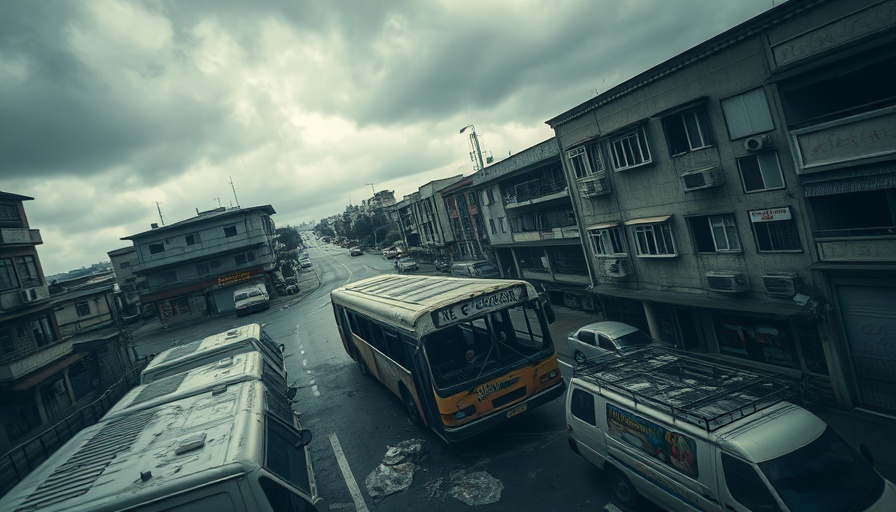
Gang Violence and Extortion: A Terrifying Reality for Peru's Citizens
In recent years, Peru has been gripped by a horrifying surge in gang violence and extortion at the hands of organized crime groups. Small businesses across the nation are becoming prime targets, as criminal organizations demand protection money and resort to violence when their demands are met with refusal. This tragic situation has transformed once-peaceful communities into war zones characterized by fear and desperation.
The Devastating Impact on Local Communities
As reported by Mitra Taj from Lima, the consequences of these rampant extortion schemes can be seen vividly in neighborhoods like Villa Maria del Triunfo. Local business owner Jorge Tejada has faced the repercussions directly; after resisting a gang's monthly payment demands, his recycling business was set ablaze, echoing the distressing stories of countless others who have succumbed to similar tactics. Such tactics have resulted in escalating violence, with innocent individuals caught in the crossfire, further deepening the trauma that families endure.
Understanding the Roots of the Crisis
This epidemic of extortion and violence in Peru does not arise in a vacuum. Several socio-economic factors have perpetuated the growth of gangs in urban areas, including unemployment, poverty, and a lack of opportunity. Many young Peruvians are lured into gang life with the promise of financial rewards in a landscape where traditional job prospects are bleak. Moreover, ineffective law enforcement and judicial systems contribute to the pervasive atmosphere of impunity, allowing criminal activities to flourish with little fear of reprisal.
Historical Context: How We Got Here
The roots of gang violence can be traced back to the internal conflicts of the late 20th century, where organized crime began to establish itself amid political upheaval and economic instability. As the government struggled to maintain control, various factions formed, many of which morphed into powerful gangs. Over the years, these groups have grown in strength, adapting to new criminal markets, including drug trafficking and extortion, as they exploit society's vulnerabilities.
Engaging Perspectives: The Community Response
Residents are not just passive victims; they are actively seeking solutions. Grassroots organizations are mobilizing to protect their neighborhoods and foster cohesion among residents. Increasing community resilience is crucial in combating gang influence, whether through local initiatives that provide opportunities for youth or collective efforts to report and resist extortion attempts. Solidarity is essential in restoring faith among citizens as they seek alternatives to the gang lifestyle.
The Role of Law Enforcement: Challenges and Limitations
Authorities face immense challenges in tackling the growing epidemic of gang violence and crime. Corruption within the police forces complicates matters, as some officers may turn a blind eye to gang activities in exchange for bribes. Critics argue that merely increasing police presence will not curb the violence unless systemic issues such as poverty and disenfranchisement are addressed. Significant reforms and public safety measures are vital to restoring law and order while earning back the trust of the community.
Future Outlook: What Lies Ahead for Peru?
While the current landscape may seem bleak, there is potential for change. As economic conditions improve and awareness rises, there may be hope that community-driven efforts will begin to take root. Reports of successful programs addressing youth unemployment and gang prevention continue to emerge from some areas. Furthermore, international support and collaboration may bring valuable resources to bolster local initiatives, offering additional avenues for redress.
An Urgent Call to Action: Global Support Needed
As the situation in Peru unfolds, it highlights not only the local challenges faced by communities but also the pressing need for international cooperation in combating organized crime. Governments and organizations at all levels must recognize the significance of collaborative efforts to tackle these issues, helping to ensure stability for future generations. Fostering understanding and support internationally will be instrumental in creating lasting change.
In conclusion, the gang violence and extortion that currently plague Peru serve as a stark reminder of the complex interplay of social, economic, and political factors that contribute to crime. Addressing these multifaceted challenges requires community participation, robust law enforcement reforms, and a commitment from global actors to lend support. Only through collective action can Peru hope to reclaim peace and prosperity.
 Add Row
Add Row  Add
Add 




 Add Row
Add Row  Add
Add 

Write A Comment